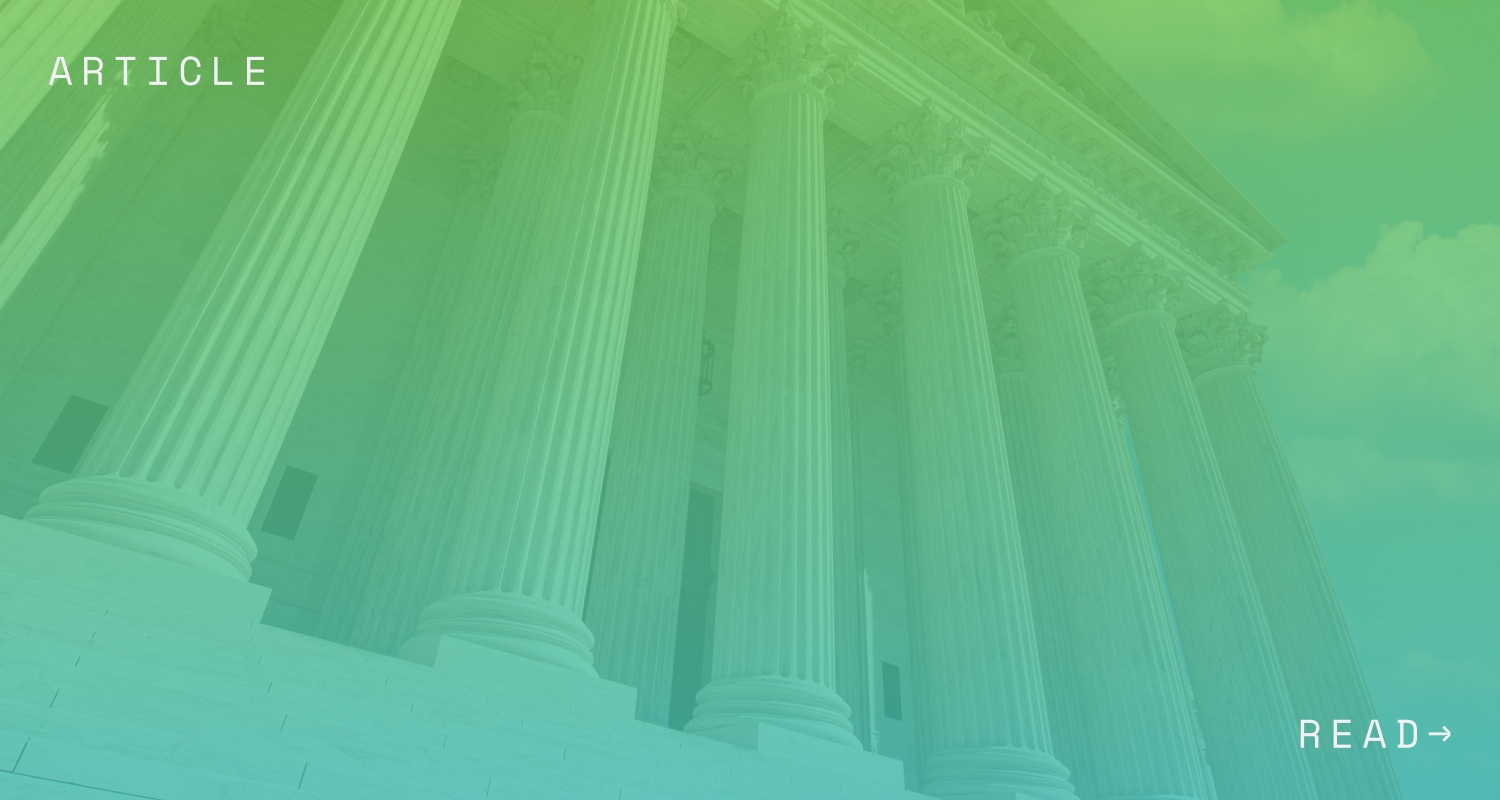Updated 3/1/21: On 2/10/21, the Department of Justice (DOJ) submitted a letter, which notified the Supreme Court that it was changing it’s prior stance in California v. Texas. Under the Trump Administration, the DOJ argued that the entire ACA should be invalidated. Under the new Biden Administration, the DOJ reverses its prior position and argues that the ACA is constitutional and should be upheld. The DOJ’s new position is unlikely to have any substantive impact on the Court’s decision.
On November 10, 2020, the Supreme Court of the United States (Supreme Court or the Court) heard oral arguments in California v. Texas, a case that many are concerned has the potential to overturn the entire Affordable Care Act (ACA). The case reviews whether the current $0 individual mandate is unconstitutional, and if so, whether that will cause the entire ACA to become unconstitutional.
Plaintiffs, a group of states led by Texas, two individuals, and the Trump Administration, argue the individual mandate is unconstitutional and the mandate is so intertwined to the rest of the ACA that the entire law should be invalidated. Defendants, a group of states led by California and the U.S. House of Representatives, argue that the individual mandate remains constitutional, and even if the mandate were found unconstitutional, it could be severed from the rest of the ACA so the law could continue without disruption.
It is widely anticipated that the three liberal Justices on the Court will rule to uphold the ACA, meaning two conservative Justices must join them to get a majority decision to uphold the law. During oral arguments, two such Justices signaled they agreed with the Defendants’ assertion that the individual mandate can be severed from the rest of the ACA. If oral arguments indicate how the Justices will rule, it is likely the ACA will be upheld.
Below is a review of how the case ended up before the Supreme Court, the main issues in the case, the possible outcomes, and what we learned from oral arguments.
How did the case end up before SCOTUS?
The ACA contains a provision called the “individual mandate” (mandate), which requires individuals to maintain health insurance or pay a tax penalty. The mandate was passed to stabilize the insurance markets and to support the ACA healthcare expansion, such as the requirement to cover preexisting conditions. In 2012, the Supreme Court upheld the constitutionality of the mandate by a five Justice majority in NFIB v. Sebelius. The Court held that the mandate was not an unconstitutional command to buy insurance, but rather a choice between purchasing insurance and incurring a tax penalty, which was a permissible use of Congress’ constitutional power to levy taxes.
Congress subsequently reduced the mandate tax penalty to $0 and Plaintiffs brought a case that argued the mandate was no longer a tax (since it was $0) and thus, the basis for its constitutionality outlined in Sebelius was no longer valid. Further, Plaintiffs argued the mandate was so tied to the rest of the ACA that it could not be separated and if the mandate was unconstitutional, so was the entire ACA.
In December 2018, a district court agreed with Plaintiffs and invalidated the ACA. The case was appealed to the 5th Circuit, which found the mandate unconstitutional, but did not decide whether this caused the entire ACA to be invalidate. The Defendants then appealed the 5th Circuit’s decision directly to the Supreme Court.
What are the issues in the case?
There are three main issues in the case:
- Standing: Do the Plaintiffs have a right to sue?
In order to have a right to bring the lawsuit, Plaintiffs must demonstrate they were injured, the injury is traceable to the Defendant, and their injury is likely to be redressed by a favorable decision. Plaintiffs claim economic injury, though the question remains whether the Plaintiffs suffered an injury from a mandate that has no tax penalty. The individual Plaintiffs allege they incurred costs from purchasing unsubsidized health insurance through the Exchange to comply with the mandate. The state Plaintiffs allege they incurred costs from having to complete reporting on coverage for their state employees and from having a larger number of residents on Medicaid (note that the costs incurred by the state do not stem from the individual mandate but from requirements under other provisions of the ACA). Both the district court and 5th Circuit found Plaintiffs had standing to sue. - Constitutionality: Is the mandate still constitutional now that the penalty is $0?
The question remains whether the $0 mandate is still considered a tax (as found constitutional under Sebelius) or whether it is now an impermissible command to purchase health insurance (which was found to be unconstitutional under Sebelius). Defendants argue that the mandate is not a command because it does not require individuals to do anything, rather Congress zeroing out the mandate only changed the legal consequence for not buying insurance. The district court and the 5th Circuit both found the mandate to be unconstitutional. - Severability: If the mandate is unconstitutional, can it be separated from the rest of the ACA or does it cause the entire ACA to become unconstitutional?
Plaintiffs argue that the mandate is intertwined with the entire ACA because the mandate was essential in enacting the other ACA provisions. Defendants argue the mandate can be separated from the rest of the law, as exhibited by the fact that the ACA market reforms have continued to function with a $0 mandate. Further, Plaintiffs argue that Congress intended to keep the rest of the ACA provisions because they did not repeal any other ACA provision when they voted to lower the mandate to $0.
What are the possible outcomes of the Supreme Court case?
There are several possible outcomes of the case:
- The ACA Continues in its Current Form: The ACA will continue in its current form if the Court finds any of the following:
- Plaintiffs Do Not Have Standing;
- The Individual Mandate is Constitutional; or
- The Individual Mandate Unconstitutional, but Severable from the rest of the ACA.
- Only Parts of the ACA Continue: If the Court finds the mandate unconstitutional, they could find that the mandate cannot be separated from certain parts of the law. This would result in certain parts of the ACA remaining in place, while other parts are struck down. For instance, the Court could find that the mandate cannot be separated from the ACA provisions protecting preexisting conditions because the mandate was passed to help offset the cost of requiring insurers to cover preexisting conditions. If this happens, the Court could then strike down the individual mandate and the preexisting condition provisions but leave the rest of the ACA intact.
- The Entire ACA is Invalidated: If the Court determines the individual mandate is unconstitutional and it cannot be separated from the rest of the law, the entire law will be invalidated.
What did we learn from oral arguments?
During oral arguments, the Court spent ample time questioning the parties on whether Plaintiffs have the right to bring the lawsuit. The Court questioned whether the Plaintiffs suffered an injury from the individual mandate, and even if they did, whether the Plaintiffs had the right to challenge the other parts of the law based on that injury. Many Justices seemed skeptical that Plaintiffs could challenge the entire ACA, with Justice Kagan noting that the Plaintiffs’ standing argument “threatens to kind of explode standing doctrine.” See Transcript of California v. Texas (Transcript), November 10, 2020, page 108, lines. 9-12. Justices also pointed out that state Plaintiffs’ alleged injuries did not stem from the mandate, but from other parts of the ACA. Chief Justice Roberts noted, “[The Plaintiffs’] theory of standing is that a person who is not actually injured by part of the law can challenge that part of the law and, through that, try to strike down other parts of the law that do challenge him or that do injure him. I think that really expands standing dramatically…you’re letting somebody not injured by the provision that is [challenged] to sort of roam around through those thousand pages [of the ACA] and pick out whichever ones he wants to attack.” See Transcript, pg. 93, lines 9-23.
There were no clear signals from the Court on which way it would rule as to the issue of the mandate’s constitutionality, though conservative Justices questioned whether the mandate could be considered a tax if it no longer raised revenue. The issue of constitutionality, however, would not necessarily be the decisive issue that would impact whether the entire ACA is invalidated. The more important issue is whether the mandate is severable from the rest of the law.
When the Court discussed the issue of severability, two conservative Justices, Chief Justice Roberts and Justice Kavanaugh, signaled that the individual mandate could be severed from the rest of the ACA. Justice Kavanaugh noted, “It does seem fairly clear that the proper remedy would be to sever the mandate provision and leave the rest of act in place, the provisions regarding preexisting conditions and the rest.” See Transcript, pg. 85, lines 7-11.
Further, both Justice Roberts and Kavanaugh said that it did not appear that Congress intended to strike down the entire ACA when zeroing out the mandate. Justice Roberts noted, “I think it’s hard for [Plaintiffs] to argue that Congress intended the entire act to fall if the mandate were struck down when the same Congress that lowered the penalty to zero did not even try to repeal the rest of the act. I think, frankly, that they wanted the Court to do that. But that’s not our job.” See Transcript, pg. 62-63.
Justice Kavanaugh noted that generally the Court has a strong presumption of severability and that Congress appeared to have wanted to preserve the protection for people with preexisting conditions. See Transcript, pg. 87, lines 11-16.
From the oral arguments, it appears that the Court is leaning towards keeping the status quo and allowing the ACA to live another day.
What happens next?
The Supreme Court will issue a final decision in the case by June 2021, at the latest. In the meantime, the ACA will remain intact.
Additional Resources
Disclaimer: This content is intended for informational purposes only and should not be construed as legal, medical or tax advice. It provides general information and is not intended to encompass all compliance and legal obligations that may be applicable. This information and any questions as to your specific circumstances should be reviewed with your respective legal counsel and/or tax advisor as we do not provide legal or tax advice. Please note that this information may be subject to change based on legislative changes. © 2020 Sequoia Benefits & Insurance Services, LLC. All Rights Reserved




